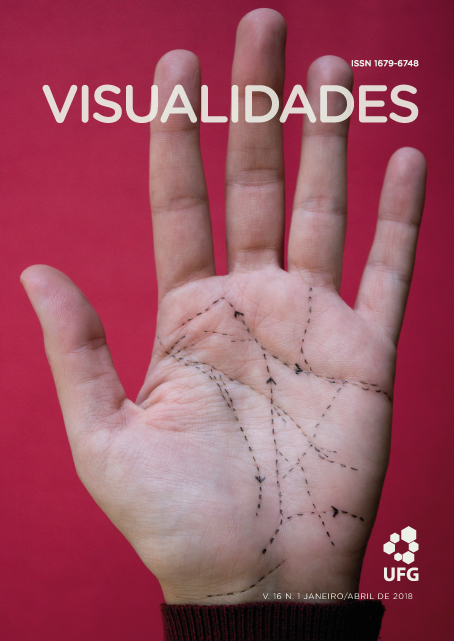Um mundo indiferente: idiotia e insignificância em “O Pequeno Quinquin” de Bruno Dumont
DOI:
https://doi.org/10.5216/vis.v16i1.45624Keywords:
Indiferença, Idiotia, Filosofia TrágicaAbstract
Based on the television series Li'l Quinquin (P’TIT QUINQUIN, 2014), by Bruno Dumont, this article proposes a preamble, under the bias of the tragic philosophy (Nietzsche, Rosset), about the indifference of the world expressed by the notions of idiocy and insignificance. After a brief contextualization of the cinematographic work of Bruno Dumont, we delineate a possible interpretation about the chosen series, equating worldly indifference and life approval. We observe, finally, that idiocy and insignificance are manifested in Li'l Quinquin not as an exception to normality, but as an expression of the human world.
Downloads
References
ALMEIDA, Rogério de. O eterno retorno do trágico: sua condição contemporânea. In: LIMA, Alessandra Carbonero; PAGOTTO-EUZEBIO, Marcos Sidnei; ALMEIDA, Rogério de (Orgs.). Antiguidades Contemporâneas: XXII Semana de Estudos Clássicos da FEUSP. São Paulo: Faculdade de Educação da USP, 2016, p. 111-127.
BARTHES, Roland. Roland Barthes por Roland Barthes. Trad. Leyla Perrone-Moisés. São Paulo: Cultrix, 1977.
BECCARI, Marcos. Articulações Simbólicas: uma nova filosofia do design. Teresópolis, RJ: 2AB, 2016.
BORDWELL, David. La narración en el cine de ficción. Barcelona, Buenos Aires, México: Paidós, 1996.
CRUCHINHO, Fausto. A televisão de Roberto Rossellini. Estudos do Século XX. Coimbra: Imprensa da Universidade de Coimbra, n. 7, p. 319-335, fev. 2007. Disponível em: < http://hdl.handle.net/10316.2/36713>. Acesso em: 26 fev. 2017.
DELEUZE, Gilles. Cinema: imagem-movimento. São Paulo: Brasiliense, 1985.
____. A imagem-tempo. São Paulo: Brasiliense, 2005.
FASSBINDER, Rainer Werner. O Anarquista da Fantasia. Rio de Janeiro: Jorge Zahar, 1988.
HIERRO, Rafael Del. El saber trágico: de Nietzsche a Rosset. Madrid: Ediciones del Laberinto, 2001.
IMDB. O Pequeno Quinquin. Website. 2014. Disponível em: <http://www.imdb.com/title/tt3053694/>. Acesso em: 26 fev. 2017.
LANLO, Jean-Marie. Appréciation: Le changement dans la continuité. Séquences: La revue de cinema. Website. 18 fev. 2015. Disponível em: <http://www.revuesequences.org/2015/02/ptit-quinquin/>. Acesso em: 26 fev. 2017.
MACHADO, Roberto. O Nascimento do Trágico: de Schiller a Nietzsche. Rio de Janeiro: Jorge Zahar, 2006.
MARX, Karl. O 18 Brumário de Luís Bonaparte. São Paulo: Boitempo, 2011.
NIETZSCHE, Friedrich. Obras Incompletas. Trad. de Rubens Rodrigues Torres Filho. (Col. Os Pensadores). São Paulo: Abril Cultural, 1983.
OLIVEIRA, Louis José Pacheco. Por uma reapropriação da ideia de homem. Tese de doutorado em Educação. São Paulo: Faculdade de Educação da USP, 2015.
OLSSON, Jan. In and out of Sync: Swedish Sound Films 1903–1914. Film History. Luton: University of Luton Press, v. 11, n. 4, fev. 1999.
REIABAPTISTA, Vítor. Estudos Fílmicos: o estado da Arte (e da Ciência). Livro de Actas - 4º SOPCOM. Faro: Universidade do Algarve, p. 1029-1033, jun. 2005. Disponível em: <http://www.bocc.ubi.pt/pag/baptista-vitor-estudos-filmicos-estado-arte.pdf>. Acesso em: 26 fev. 2017.
RICOEUR, Paul. Hermenêutica e ideologias. Petrópolis: Vozes, 2008.
ROSSET, Clément. A lógica do Pior: elementos para uma filosofia trágica. Rio de Janeiro: Espaço e Tempo, 1989a.
____. Princípio de Crueldade. Rio de Janeiro: Rocco, 1989b.
____. Alegria: a força maior. Rio de Janeiro: Relume-Dumará, 2000.
____. Le réel: traité de l’idiotie. Paris: Les Éditions de Minuit, 2004.
SOARES, Maria da Conceição Silva. O audiovisual como dispositivo de pesquisas nos/com os cotidianos das escolas. Visualidades. Goiânia: UFG, FAV, v. 14, n. 1, p. 80-103, jan-jun 2016.
XAVIER, Ismail (Org.). A experiência do cinema: antologia. Rio de Janeiro: Edições Graal, 1983.
Referência Fílmica
P’TIT QUINQUIN. Bruno Dumont. França: 3B Productions/Arte France/Pictanovo Nord-Pas-de-Calais/Région Nord-Pas-de-Calais/Le Fresnoy Studio National des Arts Contemporains/CNC/Cofinova 10/TV5 Monde, 2014.
Downloads
Published
How to Cite
Issue
Section
License

This work is licensed under a Creative Commons Attribution 4.0 International License .
Authors who publish in this journal agree to the following terms:
a. Authors retain the copyright and grant the journal the right of first publication, with the work simultaneously licensed under the Creative Commons Attribution 4.0 License which allows the sharing of work with acknowledgment of authorship and initial publication in this journal.
b. Authors are authorized to take additional contracts separately, for non-exclusive distribution of the version of the work published in this journal (eg publish in institutional repository or as a book chapter), with acknowledgment of authorship and initial publication in this journal.
c. Authors are allowed to publish and distribute their work online (eg in institutional repositories or on their personal page) after the initial publication in this journal, as this can generate productive changes, as well as increase the impact and citation of the published work ( See The Effect of Free Access).
Every effort has been made to identify and credit the rights holders of the published images. If you have rights to any of these images and have not been correctly identified, please contact the Visuals magazine and we will publish the correction in one of the next issues.






